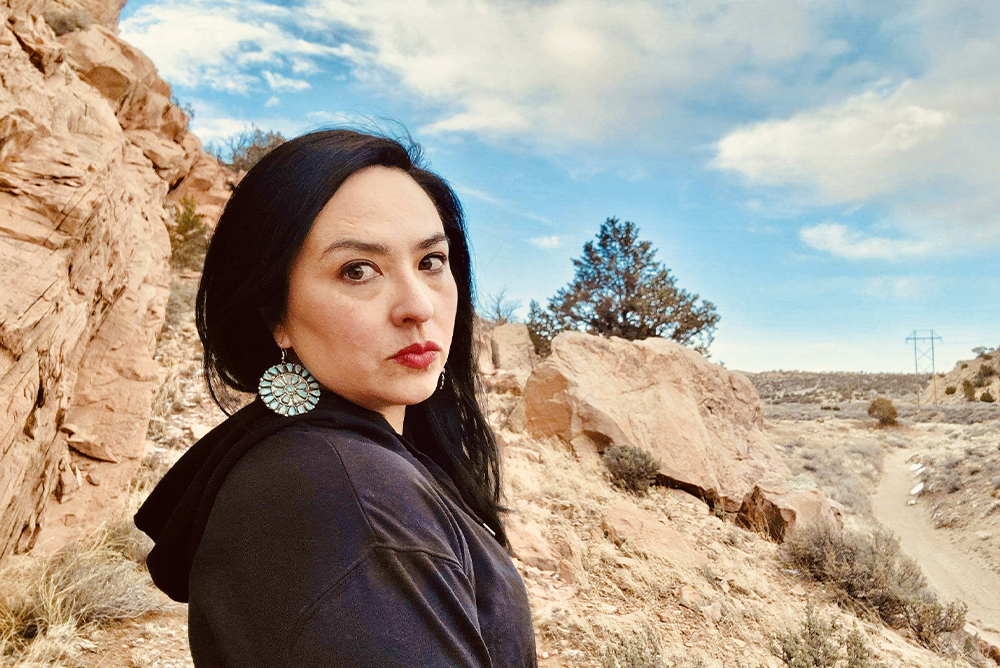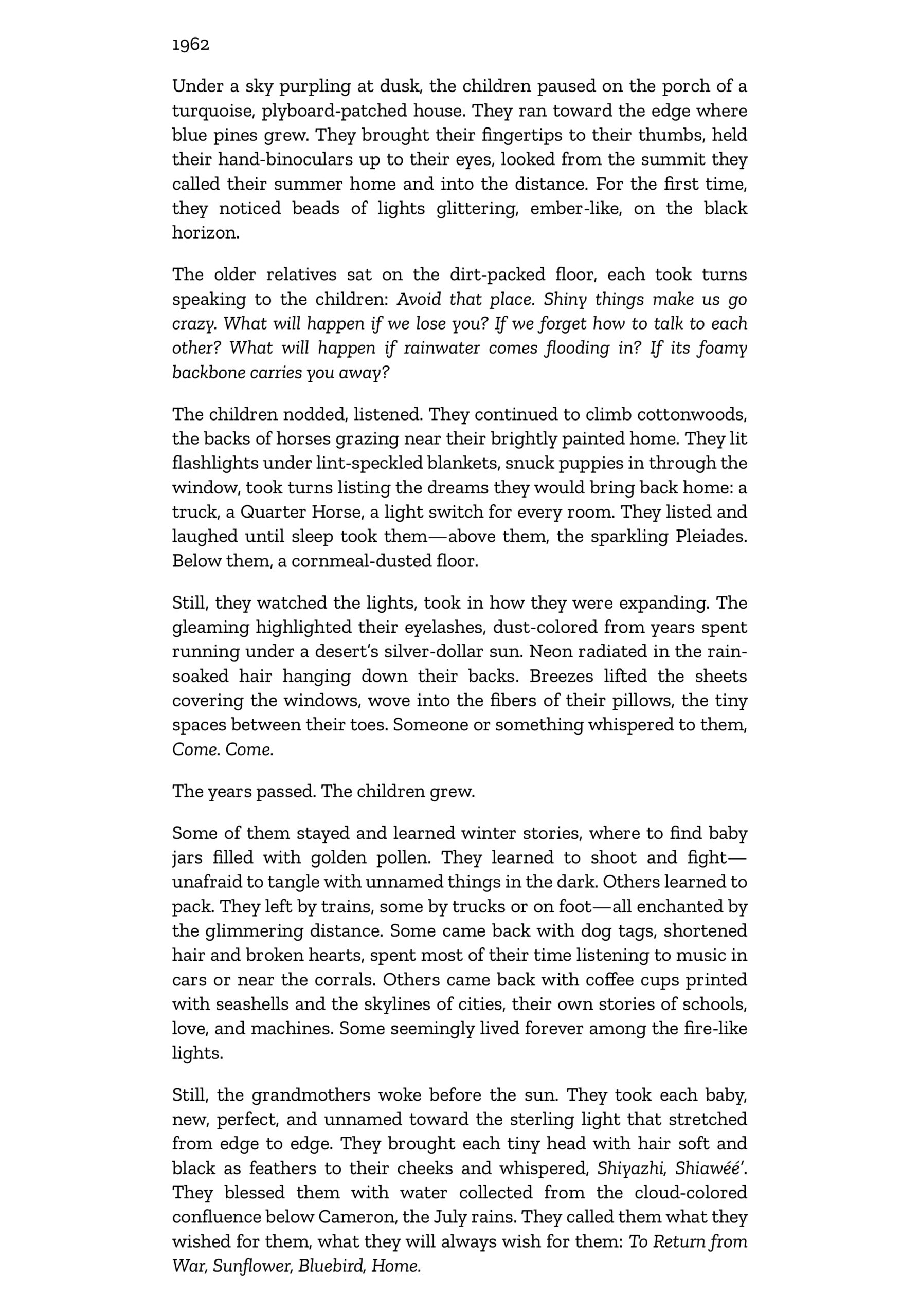
Courtesy of Paige Buffington.
Paige Buffington is the winner of the 12th annual Zócalo Public Square Poetry Prize for “From 20 Miles Outside of Gallup, Holbrook, Winslow, Farmington, or Albuquerque.” Her prose poem evokes the light, the seasons, the sounds, the colors, and the push and pull of her home, the Navajo Nation, where Buffington grew up, and where she still lives and teaches elementary school. Though the poem’s story opens in 1962, its narrative is timeless and intergenerational; whether it’s to fight a war or get an education or fall in love, the reservation is a place people are always leaving and returning to.
Since 2012, we have awarded the Zócalo Poetry Prize to the U.S. writer whose original poem best evokes a connection to place. This year, more than 700 writers submitted work to Zócalo staff and judges for consideration. We are also pleased to recognize four honorable mention poems, by Brent Ameneyro, Eleanor Stanford, Andrew Calis, and Despy Boutris, which we will publish over the next four Fridays to celebrate U.S. National Poetry Month. The Zócalo Poetry Prize is awarded in conjunction with the Zócalo Book Prize for the best nonfiction book on community and social cohesion. The 2023 literary prizes are generously sponsored by Tim Disney.
Buffington is Navajo, of the Bear Enemies Clan born for White People. She received an MFA from the Institute of American Indian Arts in Santa Fe, New Mexico. Her work has appeared in publications including Narrative, Terrain.org, Honey Literary, and the Yellow Medicine Review.
Zócalo is delighted to share Buffington’s winning poem and an interview about her home, her family, and how teaching kindergarten connects to her writing practice. She will receive a $1,000 prize and will be honored alongside author Michelle Wilde Anderson at the Zócalo Book Prize event on June 15, 2023.
From 20 Miles Outside of Gallup, Holbrook, Winslow, Farmington, or Albuquerque
Where did this poem begin for you?
With teaching, I use the problem-solving side of my brain so much that sometimes I need a prompt to get the creative side going. I was looking through flash fiction prompts, and one was, “Write a dark story in 100 words or less.” So the poem started out as a bad 100-word, little snippet of time. As I looked at it more, and the times and characters in it, I felt like there was room for it to blossom more.
Your poem title mentions five cities across northern Arizona and New Mexico—two immortalized by pop culture thanks to Breaking Bad and the Eagles, three less well-known. Why did you choose these cities?
As I started working on this poem more, it became kind of an epistolary to my mom. Her birthdate is in 1962, and when she was little, she would think, “Oh I’m going to go live in Albuquerque, I’m going to live in a big city, I’m going to live in Phoenix.” And I started thinking about the border towns around the Navajo Nation—Gallup, Albuquerque, Holbrook. When you’re driving around I-40, you see the glimmers of these places, the light pollution, the buildings, especially in the evenings because we can see for 20 miles out. They’re the big cities, the border towns to those living on the Navajo Nation.
What is your relationship to the Navajo Nation and these cities?
I live and teach in Gallup. This place has always been my home. It’s taught that when you’re inside the Four Sacred Mountains—outside of Flagstaff; by Grants, New Mexico; and two others in Colorado—you’re home. But there is also this understanding that you sometimes have to leave. You have to leave for an education, you have to leave to survive, you have to leave for peace of mind. These cities are just where people go. And they’re the big shopping centers. If you’re living on the Navajo Nation, that’s where you go for your supplies.
Also, living in Gallup, border towns come with a very heavy story. You have the alcoholism, things that happen—people go into town and never come home sometimes. But I was really trying to write it from the perspective of people my mom’s age. Now, thankfully, there are ways you can stay to get an education, but in her time, you had to leave home.
How is your relationship with home different from your mom’s?
It actually might not be that different. We both try to travel as much as we can, but this is home. Our language is here, animals are here. My mom went and got her journalism degree in Albuquerque, and then she came back and started her family here. And my grandma’s generation, they all left to Riverside, California, to get trading degrees, back at the time they were asking people to get educated in Los Angeles and those kinds of places. But for the most part everybody came back home.
Did you have your grandmother in mind while writing those characters, whose voices conclude the poem?
It was a collective grandmother. I have a lot of students who are taken care of by their grandmothers, and they always want the best for them. And then I have a specific grandmother who does give out Navajo names, and we’ll call her and we’ll ask when a new baby is born, “What should their Navajo name be?”
What role does place generally play in your poetry?
It’s the big one. I’m still working on a collection of poems I started about 10 years ago, and I decided it’s my love letter to home—that’s going to be the home book. So right now, I have these characters in it, and it’s all set in this area. The pine trees, the cottonwoods, the washes, the rain.
This is where my whole worldview is. We had a storyteller come by the school two weeks ago, and she said, “If you’re Navajo, you’re never lost, because you know where the four mountains are. Your belly button is the ground, and your head points to the sky. The sun rises in the East, and sets in the West.” There are all these cultural landmarks that I have here. I say I would like to challenge myself to write outside that, but I don’t think it would be as powerful because this is what I know. The challenge going forward would be how to make that new for me, and for readers, or maybe how it’s going to change when I get older.
How does your teaching intersect with your art?
I love teaching writing to young students, and what’s really amazing sometimes is to see how they’re writing about the same things as me—about corrals, about trees, about horses. It’s beautiful to see those reminders of our culture and how strong it is.
What poets and writers of the Southwest have inspired you?
Storyteller by Leslie Marmon Silko is the one I go back to, for the landscapes, the images, and the narrative. And Cormac McCarthy and his writing about West Texas always really takes you to that place, and every time I read it I want to write about this place the way he writes about West Texas. Sherwin Bitsui, Laura Tohe, Luci Tapahonso, Byron Aspaas—these are all poets I’m glad that we have. The way Navajo writers write about home, and the way I can see these images—they push me to think, what’s a new way to say sun?





Send A Letter To the Editors